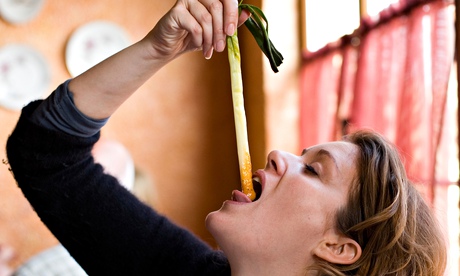
The Catalans don’t have a reputation as the most fun-loving bunch. The rest of Spain would probably describe them as hardworking and businesslike, but also tight and uptight. Their detractors have clearly never been to a calçotada, a barbecue meal unique to the area and devoted to a variety of giant spring onion. Groups of friends and family dissolve into giggles and laughter as they gather round tables set out in courtyards, put on silly paper bibs and get down and dirty with a calçot.
First, the fire-blackened outer layer of the onion is pulled away to reveal a juicy white core. Then the tip is dipped into romesco (nut and red pepper) sauce and the dripping calçot is lowered into the mouth in one go. You repeat this two or three dozen times. Do it badly and your face, hands and neck end up a black and red mess. Do it well and, er, it’s about the same.
There are mounds of grilled meat to follow, washed down with red wine from a porró, a traditional glass pitcher. Drinking from one is almost impossible unless you learn it as a baby. In unskilled hands it spouts wine everywhere except the mouth. Cue more laughter.
The town of Valls, near Tarragona, is calçot central. Tens of thousands are wolfed down during an annual festival (25 January in 2015, festadelacalsotada.com) devoted to the slippery scallion. Lots of restaurants in the Catalan countryside also do a good calçotada. The season runs from December to April. Try, for example, Sol Ric on the edge of Tarragona (calcotada €32). City dwellers have developed a taste, too – El Glop (€26) in Barcelona’s Gràcia district is a good bet.

